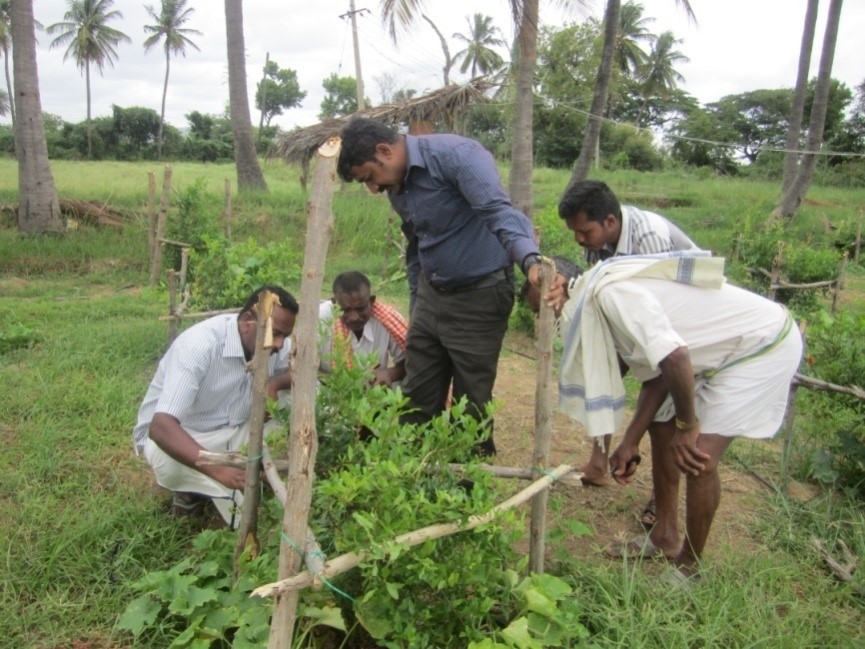
Integrated Disease Management of Bacterial Blight in Pomegranate – Ways to doubling the farmers’ income

Introduction: Pomegranate (Punica granatum), called as “fruit of paradise”, is one of the major fruit crops of tropical and subtropical region of India. The fruit is grown for its attractive, juicy, sweet-acidic and fully luscious grains. The fruits are mainly used for dessert purposes. Being a “vital cash crop”, it is grown in an area of 1.25 lakh hectares with 60.64 lakh tones of production in India and the area under the crop is also increasing very rapidly. Pomegranate occupies sixth place in the fruit export market of India, where it accounts for 50 per cent of the world pomegranate production and earns a foreign exchange to the tune of Rs. 270 crores. In Karnataka, it is grown in an area of 14,000 hectares with the production of 1.5 lakh tonnes and productivity of 10 tonnes per hectare. The most popular varieties suitable for processing and table purposes are Ganesh, Mridula, Arakta, Bhagwa, Kesar, G-137 and Khandar.
2. Situation and benchmark analysis/Problem statement: Successful cultivation of Pomegranate in recent years has met with different traumas such as pest and diseases. Among diseases bacterial blight caused by Xanthomonas axonopodis pv. punicae (Vauterin et al., 1995) is a major threat. The survey conducted by National Research Centre on Pomegranate (NRCP) from 2005 to 2009 revealed that prevalence of blight incidence was mild to severe in all pomegranate growing areas of Karnataka and Maharashtra. Prevalence of Bacterial blight in Karnataka was 58.33%, in which 27.77% orchards had moderate blight and 33.05% orchards had mild infections (Anon. 2008, 2009). Yield losses due to Bacterial blight drastically reduced to 10,000 tonnes in the year 2007-08 from 1.18 million tonnes during the year 2003-04, in a span of just four years in Karnataka (Benagi and Ravi Kumar, 2009). In addition to this, cost of cultivation is one of the major concerns nowadays, because of indiscriminate use of pesticides for the control of pests and diseases, excess application of water soluble fertilizers etc. The Data collected in this regard showed that farmers were spending an amount of Rs.2.75 lakhs to 3.10 lakhs per crop compared to actual cost of cultivation of Rs.1.25-1.38 lakhs. Any successful plant protection measure depends on early detection of the disease followed by timely adoption of recommended control measures.
3. Technology details: A technology was developed by NRCP, Solapur and ICAR-IIHR, Bengaluru, to address the Bacterial blight of Pomegranate. The technology is integrated disease management schedule which include practices like orchard sanitation, avoidance of rainy season crop (Mrig bahar) and regulating the Hasta bahar crop, judicious sprays of antibiotics like Streptocycline (500 ppm) in combination with fungicides like Carbendazim (0.15%) or Mancozeb (0.2%) or Copper oxychloride (0.3%) or Bordeaux mixture (0.1%) at 15 days intervals based on the prevailing weather conditions recorded in the local meteorological unit. An FLD on Integrated Crop Management (ICM) in Pomegranate by implementing the above technology was conducted for three consecutive years (2014-17) during Rabi season in five farmers’ fields of Sira and Pavagada Taluks of Tumakuru district. An extensive awareness cum field visit to every farmer of cluster village helped to reduce the cost of cultivation by avoiding the local quacks that were responsible for wrong advice of pesticides application. Capacity building programmes were conducted at different intervals and at different crop stages to highlight the importance of sprays to be taken up, particularly the dosage and method of chemical application. Further, periodical sprays were taken up depending on the prevailing weather parameters at different intervals and at different crop stages.
4. Yield and output details: The yield obtained in demo field was significantly superior over the control field which recorded the least yield of 6.88 t/ha, compared to demo field which recorded an average of 8.92 t/ha. The per cent increase in yield over control was recorded in demo field was 29.65 per cent. The benefit cost ratio recorded was 5.15 in Demo plot compare to check plot (2.15). The significant reduction in cost of cultivation was recorded in demo plot compared to check plot. This is mainly because of drastic reduction in number of sprays and dosage of the unwanted chemicals.
| Plot details | Yield Per ha In Qtls | % increase over control | Gross Cost In Rs. | Gross Returns In Rs. | Net Returns In Rs. | B:C ratio |
| Demo plot | 8.92 | 29.65 | 1,29,800 | 6,69,000 | 5,39,200 | 5.15 |
| Control plot | 6.88 | 2,39,560 | 5,16,000 | 2,76,440 | 2.15 |
5. Income/profit and development: Successful demonstration of ICM in Pomegranate revealed that there was a drastic reduction in cost of cultivation, which was mainly because of judicious use of pesticides and water soluble fertilizers. KVK was very much instrumental in creating the awareness among the farmers by reaching 128 pomegranate growers in Tumakuru District by new extension tools like ICT. Among all, whatsapp played a major role by connecting all the individual farmers. There is a lot of scope to increase the income by value addition and export. A farmer would be getting nearly Rs.130/Kg in international market compared to Domestic market of Rs.75/Kg. The Bio-pesticides and Bio-fertilizers (Arka Microbial Consortium) produced by KVK and used by the farmers helped to reduce the cost of cultivation to a greater extent. KVK is also promoting Farmers producers Organization (FPO) for marketing to avoid local vendors who offer very less price.
6. Conclusion: Adoption of advanced recommended package of practices along with use of bio-fertilizers helped the farmers to reduce the cost of cultivation. Doubling Farmers’ Income is very much possible in Pomegranate where farmer needs to take judicious decisions at every crop growth stage, keeping in mind the cost of inputs along with consistent liaison with government extension agency.

